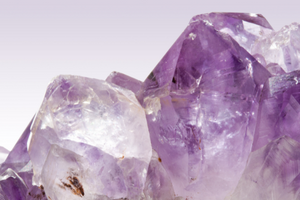Since time immemorial, mankind has appreciated and searched for precious minerals. We value the beauty of stones, their outstanding shapes and unique colours such as red, silver or gold. Precious stones have been among the most desirable raw materials worldwide for thousands of years. What are the types and features of precious and semi-precious minerals?

Precious stones throughout history and in societies
Precious stones belong to the most unique and inaccessible raw materials that exist on Earth. No wonder, therefore, that in ancient civilisations such minerals could be owned only by the wealthiest, those at the top of social hierarchy. These included pharaohs, kings, priests, aristocrats, knights, gentry as well as rich merchants and burghers. It was no earlier than within the last 200 years when precious stones became increasingly popular among wealthy factory owners, investors or independent professionals.
The value of precious stones at the turn of millennia remained unchanged, even if the market keeps offering faultless imitation gems. Certified minerals such as the diamond, emerald, and ruby remain some of the most expensive materials known to mankind. What is the reason why the interest in precious stones does not diminish? They are famous for certain unique characteristics, add prestige, and emphasise the social status of anyone who wears them.
What are precious stones and where can they be applied?
Precious stones definitely stand out amongst other stones. They are coloured or transparent minerals that are extremely rare in nature, and their extraction requires considerable outlays. A precious stone is formed as a result of transformations that occur over the span of many millennia in rocks and substances of non-organic origin.
Once extracted and processed, precious stones are used for many purposes, such as:
- jewellery (precious stones set in gold or silver can be seen in rings, necklaces, bracelets, etc.),
- the manufacturing of daily-use items (such as saw disks, watch dials, cutlery handles, high-end dresses),
- art (for example, sculptures, paintings, picture frames),
- the manufacturing of cosmetics (such as creams, brightening masks, facial scrubs),
- lithotherapy (a method of treatment with precious stones),
- metal working (as a material with abrasive or cutting properties).
What are the characteristics of precious stones?
If we take a look at stones considered to be precious, we can see certain characteristics. Regardless of whether they are big or small, precious stones shine attractively and show a high refractive index. The sun’s rays reflect inside them in many different ways. Some minerals, when exposed to light, become opalescent or show a rainbow or reflect an amazing array of colours.
One of the most typical features of precious stones is their hardness. On the 10-degree hardness scale developed by Friedrich Mohs, they get the highest scores ranging from 6 to 10. This means they can be used to scratch, or even cut, glass. Precious stones are resistant to scratches, erosion, and chemical substances.

Review of the most popular precious stones
The list of the most-valued precious stones includes more than ten minerals. However, contemporary gemmologists underscore that this number is much higher, as there are around 100 types of high-quality stones. What distinguishes the most popular precious stones? Below we present their brief review and characteristics:
- diamond – an allotropic variety of coal, the hardest and the most valuable precious stone, usually set in gold (after grinding, it is called ‘brilliant’), which is transparent, yellowish, greenish, or sometimes reddish;
- ruby – it is a variety of corundum, that is to say, a mineral having the form of aluminium oxide in red, dark-red or purple colour; it is very hard (degree 9 on the Mohs scale);
- topaz – aluminium fluorosilicate, a transparent or golden precious stone with hardness 8 on the Mohs scale, which resembles glass and can change its colour when exposed to sunlight;
- emerald – a mineral with an intensive green colour, which often contains gaseous and liquid inclusions, has a glassy sheen and a hardness 7.5 to 8 on the Mohs scale;
- opal – the name of this stone refers to the phenomenon of the play of light, known as opalescence, visible on its surface; the mineral has various colours ranging from white to blue, green and iridescent, and a hardness from 5 to 6.5 on the Mohs scale;
- sapphire – just like the ruby, it is a variety of corundum, having a glassy sheen and a blue, blue-greenish or blue-violet colour; it is a very hard mineral whose Mohs hardness degree is 9.
What are semi-precious minerals?
Colourful mineral stones, such as diamonds or emeralds, stand out by the fact that they are extremely hard and glossy. On the opposite side, there are minerals defined as semi-precious, which are those whose hardness in the Mohs scale is lower than 7. Which stones do we refer to? They include, for example:
- jasper,
- jadeite,
- fluorite,
- amethyst,
- tiger’s eye,
- amazonite.
Interestingly, the division into semi-precious stones and precious minerals is challenged by many gemmologists and jewellers. According to researchers and experts in the field, the appropriate classification only includes precious stones and regular minerals, which commonly exist in nature. We should also highlight that synthetic stones are not classified as precious or semi-precious stones.
Read also: how to check whether a stone is precious?